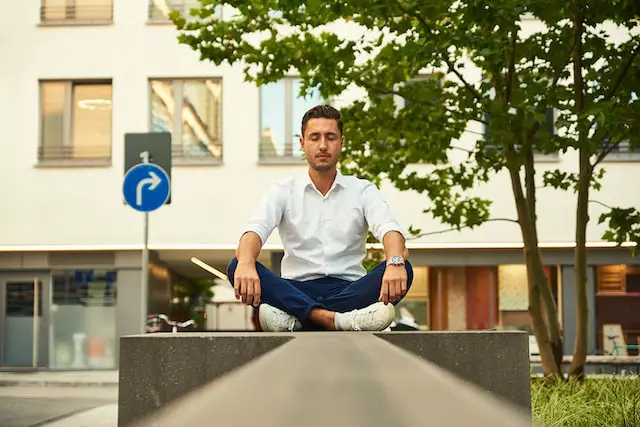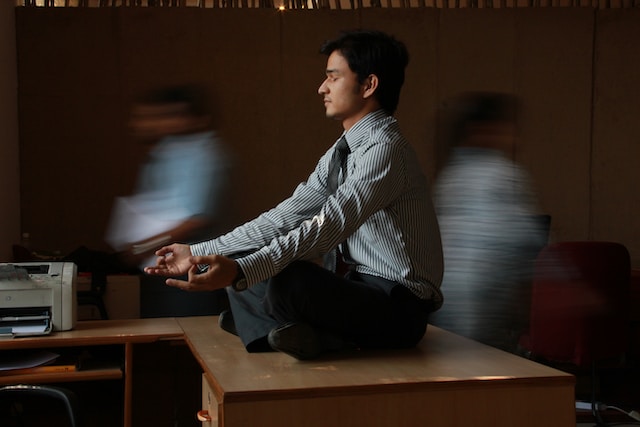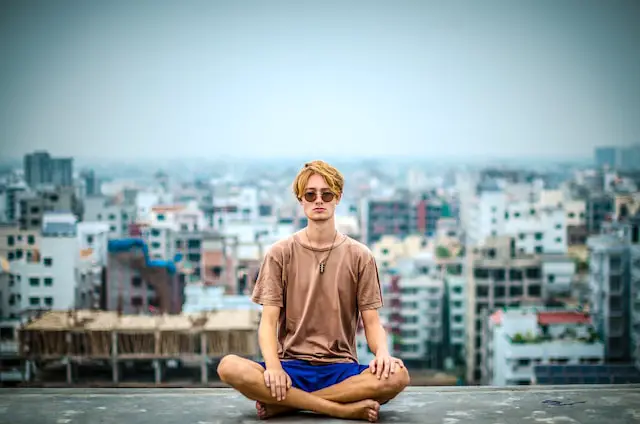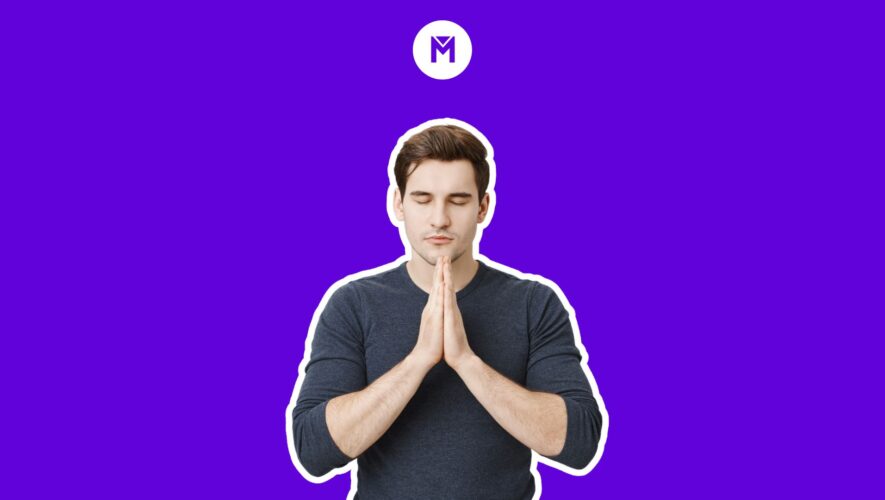In today’s fast-paced world, where everything seems to be moving at the speed of light, finding a moment of tranquillity can be a rare gift.
This is where meditation comes in, offering a refuge from the chaos and constant demands of modern life.
It has become an essential practice for high-value men and high-value women seeking balance, inner peace, and a sense of clarity amidst the hustle and bustle.
Learning how to meditate can profoundly impact your life in a variety of ways.
For starters, it can easily cut down stress, enabling you to approach challenges with a more composed mind.
Meditation also enhances your ability to achieve hyper-focus and concentration.
In a world filled with distractions, maintaining your attention is the greatest skill one can acquire.

When you learn how to meditate, you regularly nurture your mental and emotional health.
This leads to improved self-awareness, allowing you to better understand your thoughts, emotions, and reactions.
Such a level of self-awareness makes you a Sigma male. Even a recent study confirms that.
Finally, learning how to meditate allows you to sleep better, as it helps you unwind and release the tension of the day.
When you get sufficient sleep, you also enhance your physical health, specifically developing six-pack abs.
But what is meditation? Is it just a form of sitting/standing activity to calm our minds? Or is it something more?
In this detailed guide on how to meditate Like a Pro, we will explore every aspect of meditation so you don’t leave with doubt in your mind.
This blog will cover everything you require to learn how to meditate in the 21st century.
What is Meditation?
To put it simply, Meditation is a mental workout, but instead of lifting weights, you train your monkey mind to become more focused and calm.
You need to train your mind by learning how to meditate because all of your problems essentially spring from it.
Think about it, where do you feel sadness or anxiety or stress? In your mind. Right?
Imagine if you tame it in a way that you gain absolute control over your thoughts, emotions, and actions.
This is why learning how to meditate is critical in 2023 because we now have a multitude of mental health problems emerging every day.
While people may prefer therapists for short-term solutions, it’s not a long-term, sustainable approach.
The only long-term solution to all our mental health problems is controlling the source of such problems “the mind.”

When one starts learning how to meditate, they think of it only as a practice of controlling one’s mind and maintaining that state.
However, once you go a little further, you realize that meditation is not a practice, but it is the world’s deepest philosophy.
Meditation is the ability to retain one’s virtues in the face of adversity. It’s about cultivating grace and the presence of the mind through proper mental control.
Any meditator, when learning how to meditate, will experience three levels of growth.
- Level 1: Meditation is just an act, where you train your mind with discipline and determination. You’re just beginning to master your mind.
- Level 2: The stage where meditation becomes second nature, and virtues like love, compassion, and peace flow effortlessly.
- Level 3: Meditation becomes a state of mind, a state of bliss where you are undisturbed by the external world because you have your inner world in control.
At the end of all this, learning how to meditate leads to liberation that is freedom from false beliefs, negativity, and undesirable thoughts.
You become meditation; meditation becomes you. There’s no separation anymore.
Elements of a Good Meditation
While there are a multitude of elements that constitute a good meditation, when learning how to meditate, you have to focus on five basic elements that’ll assist you in the process.
These five elements are your five friends in this journey and you have to leverage them to help you reach your goal faster.
Attention
When learning how to meditate, attention is your first friend.
Attention is It’s the art of directing your awareness to a specific object or point of focus.
Attention is like a beam of light that illuminates your chosen focal point, whether it’s your breath, a mantra, a visualization, or any other object.

As long as you can maintain this attention, your meditation will be divine.
Cultivating attention allows you to gently steer your mind away from distractions and wanderings, helping you stay in the present moment.
Posture
Posture plays a significant role when learning how to meditate because it’s not just about assuming any position, but rather finding a way to be both relaxed and alert.
To facilitate a smooth flow of energy throughout your body, your body needs to be in a receptive posture.
This stable and comfortable posture enables you to stay focused on your meditation practice without being hindered by physical discomfort.
The ideal meditation posture is an 8-point posture, used by Monks for thousands of years.
- Cross-Legged: Choose a comfortable way to sit cross-legged or use a chair if needed. Keep hands and feet joined for smooth energy flow.
- Straight Back: Maintain a straight back for channelling vital life energy and awakening inner consciousness.
- Relaxed Arms: Keep your elbows slightly bent and arms relaxed to avoid fatigue and distraction.
- Joined Hands: Unite Feminine and Masculine Energies by crossing your hands or stacking one on top of the other to balance energies.
- Straight Head: Align your neck and head in a straight line to allow energy to flow freely. This also prevents you from falling asleep.
- Still Gaze: Cultivate a steady gaze to enhance concentration and energy flow. Do not let your gaze go down or up, maintain it at one point, but keep your eyes closed.
- Gentle Smile: Relax your facial muscles and smile gently to bring a sense of calmness.
- Position of Tongue and Teeth: Keep your tongue on the palate and teeth slightly parted to maintain stillness.
It looks similar to this:

This posture is the most conducive to meditation because it was designed in a way that your body, by nature, turns meditative when you assume this posture.
You have to master this posture when learning how to meditate because it is the most effective way to calm your mind.
When learning how to meditate, this posture is the most important to maintain. Later on, you can experiment with different postures too.
Concentration
Concentration is like a magnifying glass that intensifies the power of attention when learning how to meditate.
When your mind becomes single-pointed and unwavering on the chosen object of meditation, you enter a state of deep focus.

As you strengthen your concentration, you learn how to meditate because distractions fade away, and you delve deeper into your inner world.
Like a skilled archer aiming at the bullseye, concentration allows you to hit the mark of meditation with precision.
Mindfulness
Mindfulness is the heart of the process of meditation.
When learning how to meditate, you have to be fully aware of the present moment without judgment or attachment.
By observing your thoughts, emotions, and sensations as they arise, you develop a compassionate understanding of your inner world.

Mindfulness enables you to witness your experiences without getting swept away by them.
Embracing the here and now with an open heart creates a sense of clarity within you.
Alertness
Alertness acts as a watchful guardian during meditation.
It’s the quality of being vigilant and awake, preventing your mind from falling into drowsiness or getting lost in daydreams.
Just as a shepherd watches over the flock, alertness keeps your mind from wandering aimlessly and guides it back to the object of focus when learning how to meditate.

This heightened state of awareness allows you to maintain a sense of presence and deepens your connection with the meditation practice.
As you cultivate attention, find a comfortable posture, sharpen your concentration, embrace mindfulness, and remain alert.
This is your journey of learning how to meditate.
ALSO READ: Yoga for men: 18 Poses, Benefits & Pro Tips
Types of Meditation and How to Meditate
While there are a variety of meditations out there, from sound to breath and beyond, in this section, we will cover the three major forms of meditation that emerged from the Eastern philosophy.
Concentrative Meditation:
Concentrative meditation is regarded as the most challenging of all forms of meditation.
When learning how to meditate, the primary aim of concentrative meditation is to tame the mind and break free from its hardened tendencies.
As one delves deeper into this practice, the act of meditation transforms into a meditative state, where stillness, quietude, and alertness become inherent in all aspects of life.
It brings about a profound inner change, altering the way one reacts to habits, thoughts, and emotions.
Negative triggers lose their power, and they get to choose their responses wisely.
In concentrative meditation, the practitioner learns how to meditate on a chosen object, such as an image, breath, mantra, or emptiness.

Unlike other forms of meditation, concentrative meditation requires complete mastery of the posture we will discuss later, as stillness is vital for progress.
Only when the practitioner achieves perfect stillness can they transcend bodily limitations and experience a sense of cosmic oneness.
Until then, any experiences in meditation remain mere intellectual fabrications without lasting value or significance.
The stillness of the body and mind comes with great practice. Here’s how to perform concentrative meditation:
- Sit in the posture discussed later.
- Keep your back and head straight.
- Abandon all body movements.
- Put your focus on any object.
- Maintain that focus.
When learning how to meditate, you need an object of meditation.
It is what you focus your attention on during your practice.
There are four types of objects you can choose from, and you have the freedom to switch between them as needed to find what suits you best or to refresh your mind.
Meditation on Form
Learning how to meditate on a form is one of the most common yet often misunderstood forms of meditation.
It involves internal visualization rather than simply staring at an external object like a pebble, picture, or idol. Follow these steps:
- Sit comfortably in the 8-point posture.
- Observe the form (e.g., a pebble) for a couple of minutes without analyzing
- Close your eyes and begin visualizing the image of the form in your mind.
- Whenever the visualization fades, gently bring it back to your focus.
- If the image becomes hard to hold, open your eyes, look at the form again, and then continue with the visualization.
With practice, your ability to hold the mental image will improve, and you’ll experience increased mindfulness and concentration.
Meditation on Breath
Learning how to meditate on your breath is the easiest form of concentrative meditation, as it involves focusing on your breath’s inhalation and exhalation.
It is a calming practice that helps combat restlessness during meditation.
Here’s how to do it:
- Sit comfortably in a yogic posture.
- Take a few deep and normal breaths to center yourself.
- Close your eyes or partially lower your eyelids.
- Listen to the sound of your inhalation and exhalation.
- Pay attention to the small pause that naturally occurs between each breath.
Meditation on Sound or Mantra
Learning how to meditate on sound involves focusing on a repetitive sound, such as a mantra or any pleasant vocal or instrumental sound.
You can also use this form of concentrative meditation for chanting mantras by focusing on your voice.
- Sit comfortably in a yogic posture.
- Listen to the sound if it’s an external sound or chant the mantra
- Take a few deep breaths to settle your energies.
- Close your eyes and start recalling the sound or mantra mentally.
Vary the pace of recall to maintain freshness and clarity, and remember that initiation into a mantra can be beneficial but not mandatory for this practice.
You can start with the most powerful of all, “Om or Aum”.
Meditation on the Formless
Learning how to meditate on the formless is for those who prefer to meditate without focusing on specific forms or sounds.
This form of concentrative meditation is for more advanced meditators because this is aimed at Self-realization.
There are two approaches to this form:
Emptiness Meditation:
- Assume a yogic posture.
- Take a few deep breaths.
- Close your eyes and aim to remain thought-free without watching your thoughts.
Expansive Meditation:
- Sit comfortably in a yogic posture.
- Take a few deep breaths.
- Visualize a bright, effulgent light or an infinite universe.
- Gradually visualize your body disintegrating and merging with the infinite universe.
ALSO READ: 15 Reasons You Feel like a Failure (& How to Bounce Back)
Contemplative Meditation:
Contemplative meditation is a powerful practice that helps you realize your true nature beyond the transient labels and attachments of the world.
By questioning “Who Am I?” and discerning what is not the true self, you gradually discover your higher consciousness.
Remember, learning how to meditate is not just about mental stillness, but also about moving to higher levels of consciousness.
In contemplative meditation, you don’t need to perfect your posture like in concentrative meditation, but stillness and concentration are helpful.

This form of meditation leads to profound insights into the nature of reality and existence, going beyond words and intellectual understanding.
The key principle in contemplative meditation is that you become what you meditate on.
Through self-inquiry, you investigate the question “Who Am I?” and realize that the true self is beyond the temporary roles and identities we assume in the world.
Learning how to meditate on such questions helps you reach the essence of your being – the highest consciousness or the soul
It is a process where you remove all labels that do not define your true self.
The goal is to discover that one permanent label that accurately represents you.
Step-by-step Guide:
- Sit in any comfortable position. There’s no need to assume a yogic posture.
- Take a few deep breaths to relax and center yourself.
- Begin the contemplation process by eliminating what you are not. Reflect on all the material things you are attached to and ask yourself if you are truly that. Use the prompts mentioned below.
- Continue negating all attributes and temporary labels, realizing that you are beyond them. Emphasize that you are the eternal soul, beyond the dualities of life.
Prompts for Contemplative Meditation
I am not the body… I am not the mind.
I am not the senses… I am not the consciousness.
I am not a man or a woman… I am not young or old.
I am not beautiful or ugly… I am not a friend or an enemy.
I am not a father or a son or a mother or a daughter.
I am not a husband or a wife…I am not pure or impure…
I am not good or bad. I am not hot or cold…
I am not moral or immoral. I am not realized or unrealized…
I am not bound or free… I am not hated or loved.
I am not happy or unhappy… I am not foolish or intelligent.
I am not weak or strong… I am not restless or lazy.
I am not tired or fresh… I am not healthy or unhealthy.
I know no sorrow, no pain, no grief, no hurt.
I am beyond the good and bad, beyond praise and criticism…
I am beyond everything that can be thought or written, or heard or said…
I am the indestructible, indivisible, infinite, supreme soul – the purest consciousness…
I am beyond birth and death, I have existed before the universe and will exist after…
I am an independent unit but part of a complete phenomenon. I am complete…
When learning how to meditate on such prompts, you will experience a profound transformation in your life.
You’ll find yourself less affected by worldly affairs and relationships.
Criticism or hurtful words won’t sway you, as you realize your true self is beyond such superficial matters.
Mindfulness Meditation
Mindfulness meditation is a simple, practical, and powerful way to bring your focus to the present moment, allowing you to live in the now.
However, our minds often wander, seeking other moments we crave or desire, causing us to miss the beauty and bliss of the present.
Mindfulness is about paying attention to every thought and action without discrimination, whether good or bad.
Learning how to meditate using Mindfulness meditation is the easiest way for a meditator to get started.
By practicing mindfulness meditation, we can downplay negative thoughts, react consciously to life’s challenges, and experience a greater sense of ease and control.

Mindfulness meditation is not confined to a specific posture or breathing technique.
It should be integrated into everyday life by continuously asking, “What am I doing now?”
This simple question draws you to the present moment, making you calmer, sharper, and more alert. A study confirms that it can easily eliminate stress.
The practice can be enhanced by combining it with concentrative meditation.
Learning how to meditate using this method helps remove distractions and enables better focus on the present moment. It is a stress-free, complete experience that brings joy.
It can also be learned using a tool like the Black Lotus Meditation App.
Regardless of physical challenges or time constraints, mindful meditation can be easily incorporated into one’s routine for effective results.
You can learn about Mindfulness meditation in detail here.
Four Stages of Meditation
Guru Om Swami, in his book “A Million Thoughts,” explains how meditation goes through four critical stages.
These stages are experienced by every meditator until they reach the final stage.
When you’re learning how to meditate, you will also have to go through these stages.
Let’s explore each stage of meditation with an example.
Stage 1: The Busy Motorway
At the beginning of your meditation journey, you will experience constant activity in your mind, like a busy highway with thoughts flowing in all directions.
When you’re learning how to meditate, your mind will seem absolutely out of control, making it challenging to find stillness.

All meditators struggle in this stage to quiet the mind effectively.
Many meditators, when starting to learn how to meditate, tend to quit at this stage because they think the mind “cannot” be controlled.
However, those who hang on with discipline and determination reach the second stage.
Stage 2: The Suburban Road
With patience and persistent effort, you progress to the second stage, where the flow of thoughts becomes less constant but still frequent.
When learning how to meditate, this stage will seem like driving on a suburban road, where the traffic has reduced, allowing for longer periods of silence with occasional thoughts surprising you.

This is the stage where meditators start to enjoy the process a little bit because they finally think they can control their minds.
However, most people also stop at this stage because they think “This is the end of meditation,” but that’s not true—there are two more stages to come.
Remember, learning how to meditate isn’t just about reaching or stopping at a stage, it’s about making it your state of mind.
Stage 3: The Countryside Road
Advancing to the third stage, you experience more extended spans of stillness and bliss in meditation.
This is one of the sweetest stages when learning how to meditate because you start to experience the true power of meditation.
The mind becomes less restless, resembling a countryside road with occasional thoughts appearing on and off.
You gain greater control over your thoughts and achieve a heightened state of consciousness.

You gain such control over your mind that you decide what thoughts/emotions to keep and what to discard.
When mastering how to meditate, this stage makes you feel incredibly powerful because nothing can trouble your mind anymore.
People who are in this state naturally want to reach the final stage because love the bliss.
They feel powerful among those who cannot control their minds.
Stage 4: The Private Property
The final stage when learning how to meditate brings ultimate stillness and no activity of the mind.
You attain immense peace and control, similar to residing on private property.
Stage four meditators can remain undisturbed by any thought for as long as they want, demonstrating absolute control over their mind.

This is the final stage of meditation, and one who has reached here has become a “Modern Monk” who cannot be controlled, manipulated, or broken by external circumstances.
Your journey of learning how to meditate has come to an end. You’re in complete control. You won!
Now you’ve gained complete control over your mind, and you can control anything that goes in or out of your mind. Your thoughts, emotions, and reactions are yours to decide. Nothing will bother you anymore.
ALSO READ: How To Get a Deeper Voice: 8 Guaranteed Ways
Six Principles of Meditation
Guru Om Swami continues to expand on meditation by discussing the six principles of meditation that are critical to learning how to meditate.
These six principles form the basis of meditation and when learning how to meditate, you have to follow these with dedication to pass through all stages with ease.

Principle 1: No Recollection
When learning how to meditate, your mind may bring up thoughts from the past.
Instead of pursuing these thoughts, drop them and gently return your focus to the present moment.
Mindfulness will help prevent thoughts of the past from interfering with your meditation.
Principle 2: No Calculation
When you resist disturbances and let go of past thoughts, your mind may shift to the present situation, such as your surroundings or sensations.
When learning how to meditate, pay no heed to these thoughts and direct your attention back to your chosen focal point.
Principle 3: No Imagination
By dropping thoughts of the past and present with determination and alertness, your mind may create images of the future or dream of specific scenarios.
When learning how to meditate, remember that these thoughts are empty and gently let go of these thoughts.
Principle 4: No Examination
Regardless of the type of thought, refrain from analyzing them during meditation.
Avoid getting caught up in examining the why, how, and what of your thoughts.
Whatever comes, let it and whatever goes, let it. Analyzing thoughts can disrupt your concentration.
Principle 5: No Construction
As you meditate, you may experience beautiful sensations, sounds, or glimpses of altered states.
A lot of people get stuck on these experiences and want to experience these all the time.
When learning how to meditate, avoid craving these experiences, as this can distract you from your ultimate goal.
Remind yourself that desires for experiences are mere thoughts.
Principle 6: No Digression
When learning how to meditate, various emotions may arise, but avoid delving into them or seeking their causes.
Stay in the present moment and gently bring your attention back if you find yourself wandering or getting carried away by emotions.
Following these six principles of meditation will significantly ease the process of meditation.
By avoiding recollection, calculation, imagination, examination, construction, and digression, you’ll attain greater mental stability. You will master how to meditate in no time.
ALSO READ: 22+ Semen Retention Benefits to PROVE Why You Need it!
Hurdles During Meditation
Meditation is a powerful practice that can bring numerous benefits to one’s physical, mental, and emotional well-being.
However, many individuals encounter hurdles when learning how to meditate, which can sometimes make them dislike meditation.
Understanding and acknowledging these hurdles is essential for effectively navigating through them and experiencing the full potential of meditation.

Let’s explore some common hurdles you might face when learning how to meditate.
Environmental Hurdles
The environment in which you meditate can significantly impact your ability to focus and attain a state of deep relaxation.
Some common environmental hurdles that may occur when learning how to meditate are:
- Noise Disturbances: External noises, such as traffic, construction, or loud conversations, can disrupt concentration and make it challenging to maintain a peaceful state of mind.
- Uncomfortable Seating: An uncomfortable chair or cushion can lead to physical discomfort and distract you from your meditation practice.
- Inadequate Lighting: Dim or harsh lighting can strain the eyes and create an unsettling ambiance that hinders meditation.
Overcoming Environmental Hurdles
Find a quiet and secluded space for meditation to minimize noise disturbances. Invest in a comfortable meditation cushion or chair to support your posture.
Adjust the lighting to a soft, soothing level to create a calming atmosphere or move to complete darkness.
Emotional Hurdles
Emotions can be both a driving force and a hurdle when learning how to meditate. Certain emotional hurdles that may arise during meditation include:
- Anxiety and Stress: Feelings of anxiety and stress can intensify during meditation, making it challenging to relax the mind.
- Impatience and Frustration: A sense of impatience with the meditation process or frustration at not experiencing immediate results can create obstacles.
- Sadness or Grief: Unresolved emotions or past experiences may surface during meditation, leading to feelings of sadness or grief.
Overcoming Emotional Hurdles:
Approach your emotions with acceptance and non-judgment. Allow them to arise without trying to push them away.
Incorporate mindfulness techniques to observe emotions without getting carried away by them.
Mental Hurdles
The mind can be both a tool and an obstacle when learning how to meditate. This is true for people who’re trying meditation for the first time. Some common mental hurdles include:
- Restlessness: An agitated mind that struggles to stay still and focused during meditation.
- Dullness: A state of mental lethargy or drowsiness that hampers clarity and awareness.
- Stray Thoughts: Random thoughts that pop up and divert attention from the meditation object.
- Images and Memories: Vivid mental images or memories that intrude upon the meditation session.
Overcoming Mental Hurdles:
Practice deep breathing techniques to calm the mind and reduce restlessness or dullness.
Use a meditation anchor, such as the breath or a mantra, to bring the mind back from stray thoughts or images.
Cultivate patience and persistence, understanding that mental hurdles are natural and part of the meditation process.
Q&A: How to Control Thoughts During Meditation?
Many people often struggle to learn how to meditate because their thoughts seem to bother them more than usual. But why does this happen?
Well, it’s important to understand that the human mind is naturally active, generating thousands of thoughts each day.
However, most of these thoughts pass by without us even realizing it.
When learning how to meditate, the goal is often to quiet the mind and not engage in thinking.
Paradoxically, this can lead to an increase in thoughts as we try to suppress them.

It’s crucial to remember that meditation is a journey of self-realization, and it’s okay to have wandering thoughts; you shouldn’t hate yourself for not getting it right immediately.
Let’s address this issue logically and explore the nature of thoughts.
The mind thinks because that’s its natural function – just like our eyes blink.
We can’t expect the mind to stop thinking completely, as that would make us unconscious.
The key is not to resist thoughts but to observe them without attachment.
Imagine your mind as a “Gallery App” on your phone, and your thoughts are like pictures.
Instead of getting stuck on one image, keep swiping through the gallery.
Similarly, during meditation, observe your thoughts without getting entangled in them.
Don’t follow a single thought and get lost in a trail of ideas. Just let them come and go like waves.

Whenever you find yourself lost in a trail of thoughts, gently bring back your focus to your object of meditation.
In the beginning, it might be challenging to do this without getting caught up in thinking, but that’s okay.
Practice is essential, and with time, you’ll find it easier to observe thoughts.
Eventually, you’ll gain the ability to watch your thoughts like a movie – you can choose to change, keep, or let them go.
This is the most beautiful state of mind when learning how to meditate.
Remember, thoughts arise and subside within the same mind.
They have no life of their own; their lifespan is determined by your attention.
So, instead of fighting your thoughts, relax, breathe, and allow your mind to flow freely. If it wanders, gently bring it back to your chosen point of focus.
Tips for Successful Meditation
Learning how to meditate is a personal journey, and it’s essential to find what works best for you.
Be kind to yourself, and don’t feel discouraged if you encounter challenges along the way.

Everybody encounters challenges at the beginning and it’s natural.
Keep your discipline and consistency up and you’ll turn into a Modern Monk in no time.
Here are a few tips that will help you along the way.
- Consistency: Set aside a specific time each day for meditation. Consistency is key to building a habit and reaping the benefits of meditation.
- Environment: Choose a quiet and peaceful place when learning how to meditate. Minimize noise and external stimuli as much as possible.
- Posture: Find a comfortable and sustainable posture, whether it’s sitting cross-legged on the floor, using a cushion, or sitting on a chair with your feet flat on the ground. Your back should be straight to promote alertness.
- Breath: When learning how to meditate, start with using the breath as an anchor for your attention. Pay attention to the breath as it enters and leaves the body.
- Non-Judgmental Awareness: Practice non-judgmental awareness of your thoughts during learning how to meditate. Avoid getting frustrated for having a wandering mind.
- Short Sessions: Begin with shorter meditation sessions, such as 5 to 10 minutes, and gradually increase the duration as you become more comfortable.
- Different Techniques: There are various meditation techniques, such as mindfulness, concentrative, or contemplative meditation. Experiment with them.
- Guided Meditations: If you’re new to meditation, consider using guided meditation apps like Black Lotus or recordings.
- Open-Mindedness: Be open-minded and patient with the process. Meditation is a skill that improves over time, and the benefits may not be immediately obvious.
- Integration: When learning how to meditate, try to bring mindfulness into your daily activities. Practice being present and focused in your daily tasks.
A Message To The Reader
By embracing the art of meditation, you are embarking on a transformative journey toward a more balanced, focused, and enriched life.
Just like any skill, learning how to meditate takes practice, patience, and perseverance.
As you embark on this path, remember that there is no such thing as a “perfect” meditation; every session is an opportunity for growth and self-discovery.
Embrace the present moment, let go of judgment, and be kind to yourself throughout the process.
Like a seasoned athlete, the true essence of meditation lies in the consistent commitment to training the mind and cultivating a deeper connection with your inner self.
So, breathe, let go of distractions, and dive into the serenity within.

When learning how to meditate, you have to integrate meditation into your daily routine to find its benefits beyond the cushion – empowering you to tackle challenges with grace.
Now, armed with the knowledge and techniques we have shared, you are ready to meditate like a pro.
Embrace the stillness, harness the power of your mind, and let your journey toward self-discovery and inner peace unfold.
Remember, the magic of meditation lies not in its complexity but in its simplicity, and the profound impact it can have on your life is limited only by the dedication you bring.
So, take that first step, and let the transformative power of meditation guide you to a more mindful, harmonious, and purposeful existence.
Embrace the beauty of the present moment, for within it lies the key to unlocking your full potential as you embark on this empowering and enlightening quest of becoming the master of your mind and life.
It’s time to start learning how to meditate. All the best, King!
-Team MenVerve



